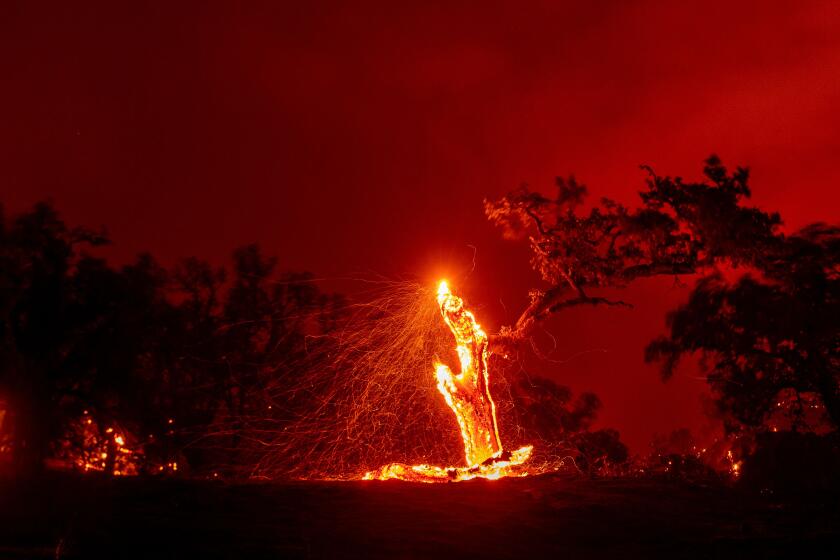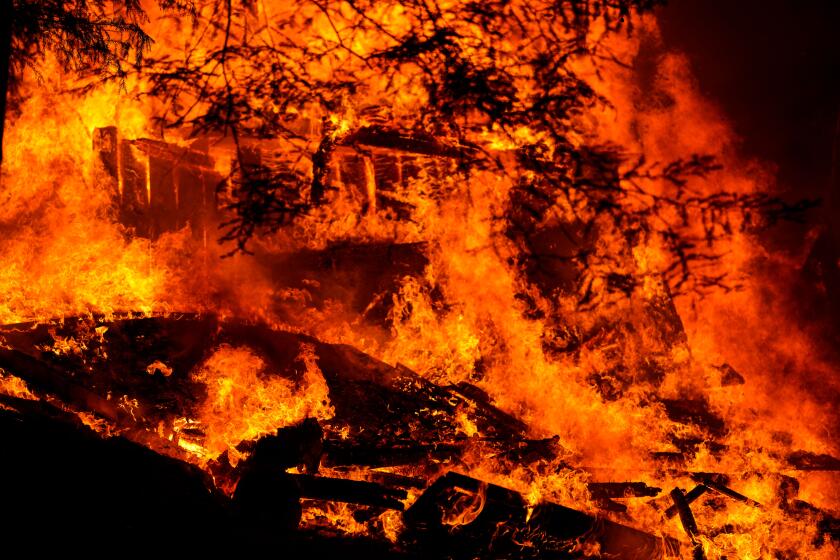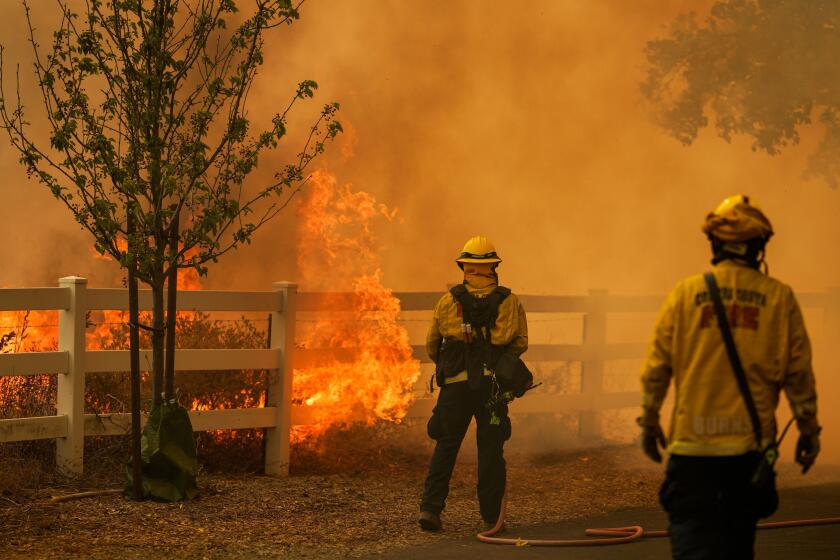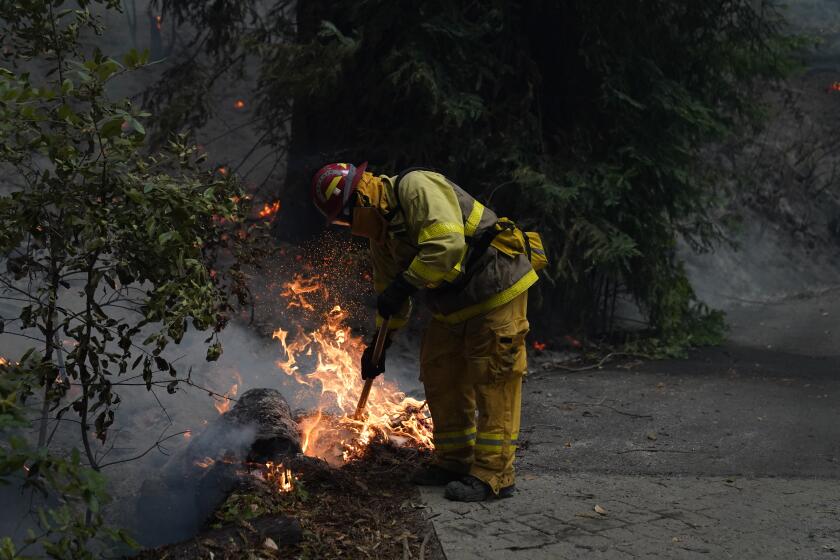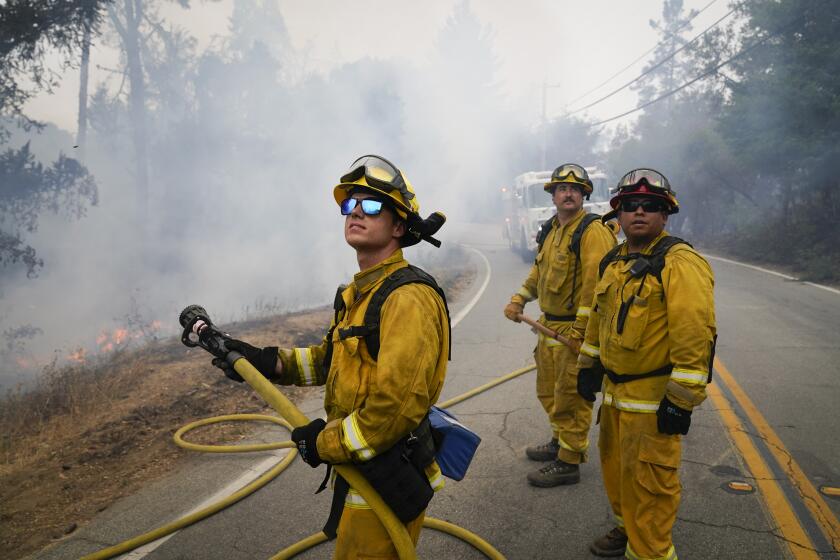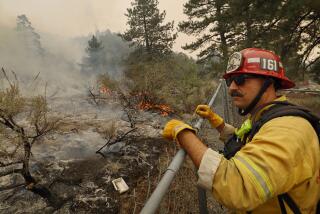âSignificant progressâ as weather helps in battle against historic Northern California wildfires
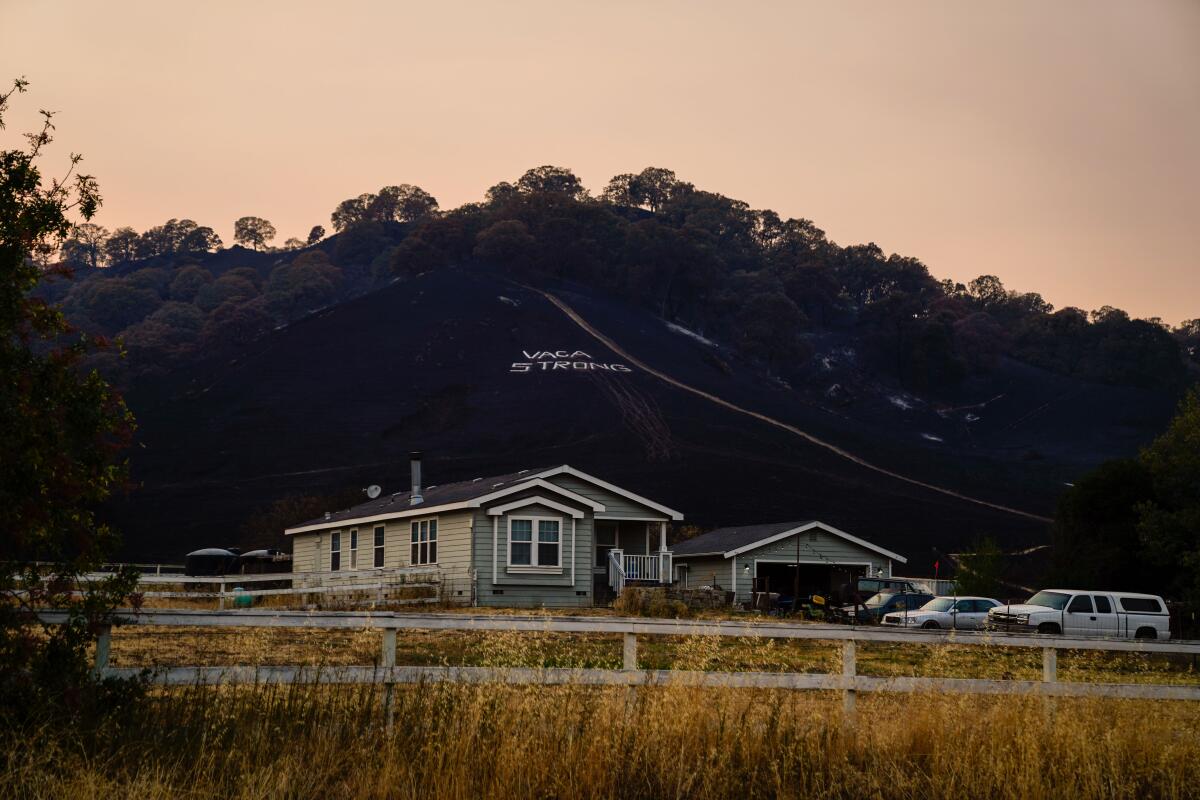
Favorable weather conditions gave crews on the front lines of the historic firestorm in Northern California a boost, as officials reported scant overnight growth on two of the largest blazes the state has seen.
Although the progress is encouraging, the widespread wildfires continue to take a dramatic toll, and not just in terms of acres burned.
More than 136,000 people across the state have been evacuated from their homes, officials said Tuesday.
The fatalities among the fires stand at seven, including five who perished as a result of the LNU Lightning Complex fire â three in Napa County and two in Solano County â and one in the CZU Lightning Complex fire burning in San Mateo and Santa Cruz counties. A pilot also died in a helicopter crash in Fresno County while on a water-dropping mission for the Hills fire.
Northern California wildfires rage through the region with possible more on the way
Seven people also have been reported missing in the area of the CZU Lightning Complex, according to Santa Cruz County Sheriffâs Chief Deputy Chris Clark.
The SCU Lightning Complex Fire â which ranks the second-largest in California history â was 20% contained as of Tuesday evening.
âA lot of good work has happened in the last 24 hours,â said Cal Fire Operations Section Chief Tim Ernst. âWe no longer see a threat of forward movement of the fire.â
About 1.25 million acres have burned in the last 10 days. More than 1,400 structures have been destroyed in the recent firestorm, and âour preliminary assessments indicate that number could rise in total to over 3,000,â according to Daniel Berlant, an information officer for the California Department of Forestry and Fire Protection.
âThere is nothing more stressful for evacuees than to know whether or not their home was able to survive the wildfire, and weâre trying to provide that information as quickly as possible,â he said in a video briefing Tuesday.
As the death toll from Northern California fires rose Monday, officials used a break in the weather to make progress against lightning-sparked blazes.
Although not as large as some of the other blazes burning in the northern part of the state, the CZU Lightning Complex fire has been a major contributor to that destruction. Officials said Tuesday that the fire had destroyed 443 structures, the majority in Santa Cruz County. About 77,000 people have been evacuated.
Officials noted, however, theyâd made great strides. Containment of the more than 79,000-acre blaze is now at 18%. Authorities on Tuesday afternoon also lifted all remaining evacuation warnings in Santa Clara County and in an evening media briefing officials described the situation as looking much more positive than last week.
âThe past couple of days, weâve seen significant progress in our firefight on this incident,â Cal Fire Operations Chief Mark Brunton said during a briefing earlier in the day. âThe weather has really cooperated with us. Weâre steadily getting a trickle of resources in. As soon as weâre getting those resources, weâre putting them to work.â
Years of feedback have improved that emergency alert system in Northern California, but some problems remain
Forecasters had expressed concern Sunday about a weather system, which was off Central California and moving toward the Monterey area, that had the potential to generate thunderstorms. Bay Area forecasters said Monday, though, that most of the moisture had moved north, spurring the early cancellation of a red-flag warning there as well as along the northern Central Coast.
Red-flag warnings â which indicate that dangerous fire weather conditions are expected â had been lifted for all but the northeastern corner of the state as of Tuesday morning.
The city of Santa Cruz and the campus of UC Santa Cruz are also âlooking very well-protected,â Brunton added, âand with our expected weather, weâre not very concerned with any further push there.â
Authorities ordered the campus to evacuate last week as the fire danger grew.
âThere is no fire activity on campus or in the city of Santa Cruz, and we hope that all the campus actions have been taken in an abundance of caution,â university officials wrote in an update Tuesday morning.
Ian Larkin, unit chief for Cal Fireâs San Mateo Santa Cruz Unit, called the fire a âhistoric event.â
âWe have never seen fire like this in the recent history that we have any records for,â he said Tuesday. âThis fuel is very receptive due to drought conditions, so any changes in the weather, though we have good predicted weather for the future, could change that environment.â
Crews also reported progress in containment of the LNU Lightning Complex fire, which at more than 356,000 acres is the third-largest blaze in California history. Officials reported that only about 1,100 additional acres had burned from Monday night to Tuesday morning, and the fire is now 27% contained.
The blaze, burning in Napa, Sonoma, Lake, Solano, Yolo and Colusa counties, had destroyed 937 homes and other buildings as of Tuesday morning.
In a sign of the progress firefighters have made recently, the Sonoma County Sheriffâs Office on Tuesday lifted a number of evacuation orders and warnings on the Sonoma Coast, east of Dry Creek and south of the Russian River, as well as in Windsor and the city of Healdsburg.
Some evacuation orders that had been issued in Napa County also were downgraded to warnings.
While trending in the right direction, Cal Fire Unit Chief Shana Jones said the incident remains âvery dynamic,â with active fire in some areas and others that âare in mop-up and control.â
She also cautioned that âonce this fire is done, we still have a very long time to go.â
âWe are in the middle of peak fire season. That means that you need to have a plan; you need to be prepared,â she said during a briefing Tuesday.
Firefighters also saw relatively modest growth overnight of the 365,772-acre SCU Lightning Complex fire, with about 3,700 additional acres burned.
âWe are essentially living in a mega-fire era,â Jake Hess, a Cal Fire unit chief, said at a news conference Monday. âWe have folks who have been working for Cal Fire for the last five years, and that is all they understand, mega fires, since they started.â
Firefighters saw a welcome respite in dangerous fire weather with the cancellation of a red-flag warning for the Bay Area.
The SCU Lightning Complex, which spans seven counties, began as a collection of about 20 blazes in areas of Contra Costa, Alameda, Santa Clara, Stanislaus and San Joaquin counties and by Sunday had merged into two conflagrations.
Eighteen structures have been destroyed. On Tuesday evening, officials had reduced several evacuation orders in Alameda and Santa Clara counties to warnings, and lifted some warnings.
Fremont Fire Chief Curtis Jacobson asked residents to be patient.
âWe will roll back the orders and the warnings as soon as we know that itâs safe for you guys to repopulate,â he said.
As of Monday, crews were battling 625 fires statewide, according to Gov. Gavin Newsom.
Many of those are the result of what officials have described as a âlightning siegeâ that began Aug. 15. There have been more than 13,000 lightning strikes statewide since that date, according to Cal Fire.
As fires burn throughout the Santa Cruz Mountains, some residents of Bonny Doon are staying put and fighting the fires that outside agencies canât or wonât take on.
So far this year, firefighters have responded to 7,002 fires that have scorched a combined 1.4 million acres, he said. Thatâs more than the land area of the state of Delaware.
By comparison, at this time last year there had been 4,292 fires that had consumed about 56,000 acres.
Newsom called this week critical âas it relates to addressing and suppressing these wildfiresâ and said the state was âdeploying every resource at our disposal.â
The sudden rash of wildfires sparked during the lightning siege stretched resources. However, California has since augmented its arsenal, thanks to pledges of equipment and personnel from other agencies â including 91 fire engines from Arizona, Idaho, New Mexico, Texas, Oregon, Utah and Washington.
Additional resources also can be freed up as crews get a better handle on some of the stateâs longer-burning blazes.
Officials on Tuesday lifted all remaining evacuations that were implemented because of the Lake fire, which ignited in Los Angeles County near Lake Hughes on Aug. 12. That fire has burned 31,089 acres and is now 70% contained.
Containment also has increased for two fires south of Salinas in Monterey County. The River fire, which has burned 48,424 acres, was 43% contained as of Tuesday evening; while the 6,695-acre Carmel fire was 40% contained.
But a number of other sizable fires continue to chew up parts of California.
Among those are the W-5 Cold Springs fire in Lassen County, which was 65,000 acres and 15% contained as of Tuesday evening.
The Sheep fire has burned 27,411 acres southwest of Susanville in Plumas County, with 3% containment.
Times staff writers Rong-Gong Lin II, Maura Dolan and Susanne Rust contributed to this report.
More to Read
Sign up for Essential California
The most important California stories and recommendations in your inbox every morning.
You may occasionally receive promotional content from the Los Angeles Times.
